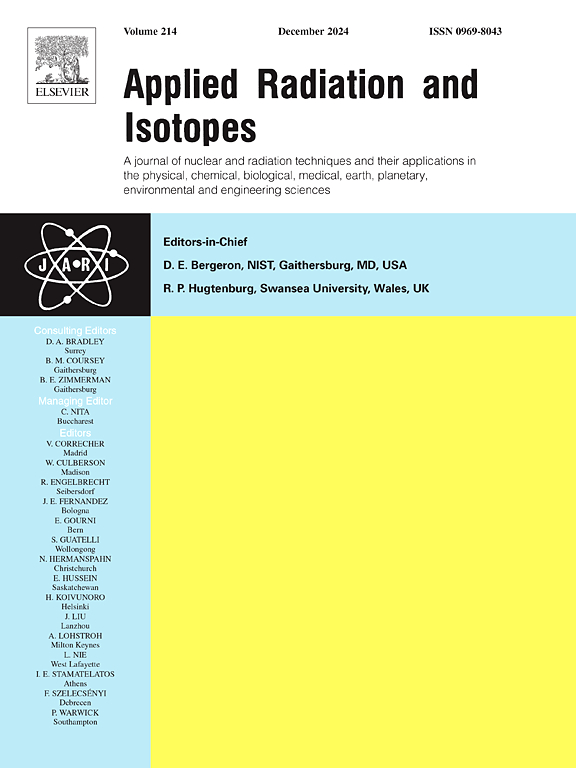旋转和扫描空间分辨率对高能光子束中嘎变色薄膜响应的影响
IF 1.6
3区 工程技术
Q3 CHEMISTRY, INORGANIC & NUCLEAR
引用次数: 0
摘要
影响变色膜剂量测定结果精度的主要参数之一是辐照膜的扫描程序。本文研究了薄膜扫描分辨率和薄膜在平板扫描仪内的取向对最终变色薄膜响应的影响。本研究采用了变色EBT2薄膜。利用ELEKTA紧凑型直线加速器产生的6 MV临床光子束,将薄膜切割成2 × 1 cm2,以0 ~ 600 cGy的不同剂量照射。为了评估扫描空间分辨率对薄膜响应的影响,分别对dpi值为50、72、200和300的辐照薄膜进行扫描。据此,测量相关信噪比(SNR)。此外,在扫描方向0度、30度、60度和90度的不同角度对膜进行扫描,获得相应的剂量响应曲线,并对扫描床内膜取向的影响进行比较。结果表明,这两个参数对薄膜响应都有可测量的影响。通过增加dpi值,信噪比降低(例如,将dpi从50更改为300,信噪比降低约50%)。扫描床内的膜旋转也会显著影响膜的剂量响应曲线,因此从0°到90°的膜旋转可以最大程度地改变59%的膜响应。综上所述,较低的扫描dpi值(小于100)可以提高所开发的膜剂量测定系统的膜响应信噪比和精度。此外,在扫描床内读取胶片时,应避免任何胶片旋转,因为它会大大改变胶片响应和相关剂量学数据。本文章由计算机程序翻译,如有差异,请以英文原文为准。
Effects of rotation and scanning spatial resolution on gafchromic film response in high energy photon beam
One of the main parameters which can affect the precision of the gafchromic film dosimetry results is scanning procedure of irradiated films. The effects of film scanning resolution as well as film orientation inside the flat-bed scanner on the final gafchromic film response have been evaluated in the current study.
Gafchromic EBT2 films were used in the current study. The films were cut into 2 × 1 cm2 and irradiated by different dose levels of 0–600 cGy using 6 MV clinical photon beam produced by an ELEKTA compact linear accelerator. To evaluate the effect of scanning spatial resolution on film response, irradiated films were scanned with different dpi values of 50, 72, 200, and 300. Accordingly, relevant signal to noise ratios (SNR) were measured. Furthermore, films were scanned at different angles of 0-, 30-, 60-, and 90-degrees respect to the scan direction and corresponding dose-response curves were acquired and compared to assess the effect of film orientation inside the scanner bed.
The results showed that both parameters have a measurable impact on the film response. The SNR decreased by increasing the dpi value (e.g. SNR reduces about 50 % with changing dpi from 50 to 300). Film rotation inside the scanner bed can also considerably affect the film dose-response curve so that the film rotation from zero to 90° can change the film response by 59 % at the maximum level.
Based on the results, it can be concluded that lower scanning dpi values (lower than 100) can improve the film response SNR and precision of the developed film dosimetry system. Furthermore, any film rotation during the film readout inside the scanner bed should be avoided, because it can considerably change the film response and relevant dosimetry data.
求助全文
通过发布文献求助,成功后即可免费获取论文全文。
去求助
来源期刊

Applied Radiation and Isotopes
工程技术-核科学技术
CiteScore
3.00
自引率
12.50%
发文量
406
审稿时长
13.5 months
期刊介绍:
Applied Radiation and Isotopes provides a high quality medium for the publication of substantial, original and scientific and technological papers on the development and peaceful application of nuclear, radiation and radionuclide techniques in chemistry, physics, biochemistry, biology, medicine, security, engineering and in the earth, planetary and environmental sciences, all including dosimetry. Nuclear techniques are defined in the broadest sense and both experimental and theoretical papers are welcome. They include the development and use of α- and β-particles, X-rays and γ-rays, neutrons and other nuclear particles and radiations from all sources, including radionuclides, synchrotron sources, cyclotrons and reactors and from the natural environment.
The journal aims to publish papers with significance to an international audience, containing substantial novelty and scientific impact. The Editors reserve the rights to reject, with or without external review, papers that do not meet these criteria.
Papers dealing with radiation processing, i.e., where radiation is used to bring about a biological, chemical or physical change in a material, should be directed to our sister journal Radiation Physics and Chemistry.
 求助内容:
求助内容: 应助结果提醒方式:
应助结果提醒方式:


